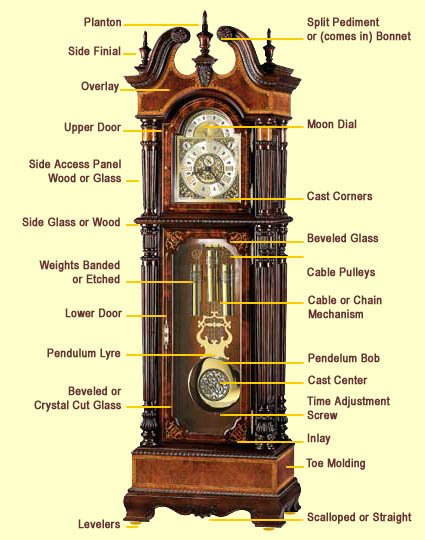All Key Parts of Grandfather Clocks Labeled
Fashion Breaks Its Silence on Harvey Weinstein Scandal
October 13, 2017Nicki Minaj, Always in Control
October 16, 2017All Key Parts of Grandfather Clocks Labeled
- Antique Grandfather Clock
- antique grandfather clocks
- black forest grandfather clocks
- Clock
- Clocks
- Clocks-Floor
- Contemporary Grandfather Clocks
- Floor Clock
- floor clocks
- German Grandfather Clocks
- Grandfather Clock
- Grandfather Clocks
- grandfatherclock
- grandfatherclocks
- Grandmother Clocks
- hall clocks
- hermle clocks
- hermle floor clocks
- Hermle Grandfather Clocks
- Howard Miller Grandfather Clock
- Howard Miller Grandfather Clocks
- Interior Decorating
- Kieninger Grandfather Clock
- Kieninger Grandfather Clocks
- Timepieces
Now is your chance! A Guide to (most) every part of a grandfather clock, with each part labeled. Just about the only part not named and pointed to is the grandfather clock mechanical German movement. The clock pictures is a classic Howard Miller Grandfather Clocks from the Howard Miller Clocks Ambassador Collection.
Here are the many parts shown, and this could be useful for any owner or prospective owner of a grandfather clock. We weill name them by number:
- Split Pediment, also known as Swan’s Neck, is pictured. The 2 other most common grandfather clock tops are Bonnet Tops, which are more rounded, and top or flar square tops. Upside down U-shaped grandfather clocks, a frequent design in older Hall Clocks, is also regaining in popularity.
- The Moon Dial on the grandfather clocks face. It rotates once every 29 1/2 days, to correlate with the frequency of a full moon rotation. The moondial is usually set so that the full moon is set to be at the 12 o’clock mark when the actual full moon is out. In the olden days, farmers used to used the moonphase dial to help for both planting and picking their crops.
- The Planton, which is essentially the center finial in the top center of the clock.
- The 2 Side Finials.
- The gorgeous overlay, frequently done in other woods, to add a tremendous touch of elegance to the grandfather clock.
- The Upper Door, which when open, exposes the dial or the face.
- The 2 side access panels, generally historically made of wood (sometimnes with mesh), but in more recent years many more are made with glass, important so that grandfather clock owners can see the inner workings of the grandfather clock movement.
- The cast corners, which are part of the columns, and add to the elegance of the woodwork, and show the effort that goes in to making these fine clocks.
- The Side glass or wood, once again by design and preference, with wood sides generally being much more common on older and antique clocks.
- Beveled glass, with the glass cut at a side angle, adds so much elegance to grandfather clocks, or any piece of furniture for that matter.
- The Cable Pulleys or Cable or Chain Mechanism, with the movement actually being behind the dial or face of the clock.
- The Pendulum Bob, which is the round part at the bottom of the pendulum, which swings back and forth. We are still trying to locate Bob!
- The Weights, generally 3 of them, with one being for time, one for strike, and one for the grandfather clocks chimes.
- The lower door, which gives access to the weights and pendulum, compared to the upper door, where the clock is wound with cable-driven keywound mechanisms. The lower door frequently has a lock on it.
- The pendulum lyre, just above the pendulum bob, and is in the shape, well, of a lyre.
- The pendulum bob will sometimnes have a cast center with a special design, and sometimes be more simply functional and plain, generally made of brass.
- The bottom of the pendulum has a time adjustment screw, which can be used to help make the clock go faster is slower. Raising the time adjustmentment screw makes the clock go faster, and lowering it makes the clock run slower.
- Inlay, or another kind of overlay, can also add wooded accents to make a clock more elegant.
- The feet or bottom of a clock can be either scalopped or straight, or something in between, limited only the the designer and builder of the grandfather clock.
- Levelers at the bottom of grandfather clocks — and much furniture — can be adjusted to ensure that the grandfather clock is level, which is necessary not only for proper timekeeping, but sometimes also to prevent the grandfather clock from simply not running.
This grandather clock annotated document should be a useful source not onlt for current grandfather clocks and grandmother clocks owners, but also for those who are thinking of purchasing a new grandfather clock.
At 1-800-4CLOCKS, we relish the opportunity to talk with individuals who are thinking about acquiring a new grandfather clock. We are pleased to talk about any/all aspects, whether you are just beginning you grandfather clock search, or are narrowing down your final choices. Always feel free to call us at 1-800-4CLOCKS (1-800-425-6257).

Guide to Grandfather Clocks
Save
